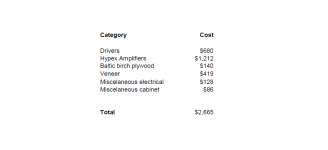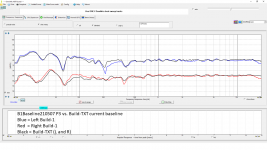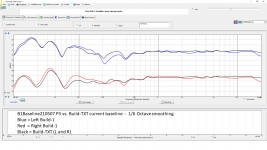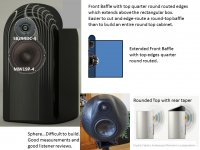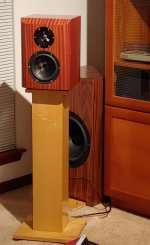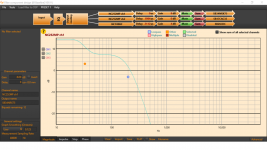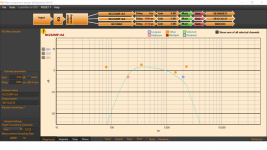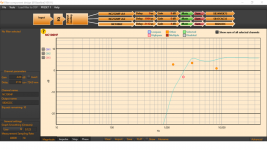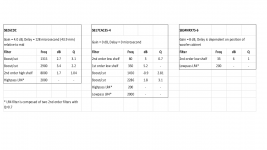Some people have asked me for a cost breakdown of this system. When I added it up, I was mildly surprised to find that the PSA (peel-and-stick) veneer was one of my biggest expenses. I had a lot of surface area due to the woofer cabinets, the stands, and the satellites.
Attachments
I used this system daily from April 2020 to February 2021 for music and movies. I enjoyed the system immensely, and I was very impressed with how good it sounded. I knew this would be a “starter” system to get comfortable with the Hypex Fusion amps, gain practice, and to generally jump back into speaker building after a 20-year absence. Nonetheless, I found the SB17CAC35 and SB26CDC combination to be very satisfying despite the modest cost of the drivers.
Beginning in February I switched the satellites to my new Satori-Textreme-based system, as documented in this thread. New active Satori Textreme
After carefully evaluating the Textreme system for 3 months, I have switched back to the First system to see if my subjective opinion has changed. That is the point of this post.
One thing I learned while developing the Textreme system was how to model the DSP filters in VituixCad2. This allows for a more precise and optimized filter development compared to the iterative test-modify-test-modify method I used originally. I discuss this in post #113. Naturally I applied this new knowledge to the First system, and this resulted in a more refined DSP filter which I developed last week. It is not a big difference from the filter I had been using (since July 2020), but it is measurably and subjectively superior. Crossovers are 200 Hz LR4 and 2 kHz LR4.
The new filter for the First system has a response very close to the Textreme system, as shown in the two plots. I wanted to be certain that the differences I might hear between the two systems would be due to driver differences, and not merely the result of small variations in frequency response. That is why I made the following plots, and why I am showing them in this post. The blue and red curves are the left and right First system. The black curves are the left and right Textreme system. One curve has no smoothing and 5 dB/division, the other has 1/6 octave smoothing and 3 dB/division.
With responses this similar, it is not surprising that the First system sounds so similar to the Textreme system.
Beginning in February I switched the satellites to my new Satori-Textreme-based system, as documented in this thread. New active Satori Textreme
After carefully evaluating the Textreme system for 3 months, I have switched back to the First system to see if my subjective opinion has changed. That is the point of this post.
One thing I learned while developing the Textreme system was how to model the DSP filters in VituixCad2. This allows for a more precise and optimized filter development compared to the iterative test-modify-test-modify method I used originally. I discuss this in post #113. Naturally I applied this new knowledge to the First system, and this resulted in a more refined DSP filter which I developed last week. It is not a big difference from the filter I had been using (since July 2020), but it is measurably and subjectively superior. Crossovers are 200 Hz LR4 and 2 kHz LR4.
The new filter for the First system has a response very close to the Textreme system, as shown in the two plots. I wanted to be certain that the differences I might hear between the two systems would be due to driver differences, and not merely the result of small variations in frequency response. That is why I made the following plots, and why I am showing them in this post. The blue and red curves are the left and right First system. The black curves are the left and right Textreme system. One curve has no smoothing and 5 dB/division, the other has 1/6 octave smoothing and 3 dB/division.
With responses this similar, it is not surprising that the First system sounds so similar to the Textreme system.
Attachments
I had made a rather detailed subjective comparison between the First system and Textreme system in post #118 https://www.diyaudio.com/forums/multi-way/366347-active-satori-textreme-12.html#post6543808 I still agree with what I wrote there.
I very much agree with this, no change in my opinion. If anything, the sound quality of the First system is better than ever with the new DSP filtering.
Again I agree with this, but I would also add that the Textreme system has slightly better dynamics. Percussion instruments sound more real, more impact, more punch. And the Textreme system will play louder before it sounds strained, although with either system, this is well past my comfort level or safety level. On the other hand, I now feel the First system (with new DSP) is equal to the Textreme system in terms of three-dimensional spaciousness, and the level of detail. But somehow the Textreme system is just slightly more real, more natural sounding. At this point it is a very small difference. Given the cost delta between the SB ceramic drivers and the Satori Textreme drivers, some people may not feel the small difference in performance is worth the price. There is no doubt that the SB17CAC35 and SB26CDC combination is capable of very high performance, and is an excellent bargain.
j.
The SB17CAC/SB26CDC system has a lot of detail and clarity. Especially in the very soft quiet moments where they maintain details down to very low SPL. This allows them to convey a very realistic studio or hall ambience, where a plucked string slowly fades to black, or a cymbal rings down to nothing. They transition from soft to loud to soft very realistically. The system is very three dimensional with an excellent presentation of space. Considering the price, this combination is one of the best bargains in DIY
I very much agree with this, no change in my opinion. If anything, the sound quality of the First system is better than ever with the new DSP filtering.
I was not sure that the SB ceramic drivers could be improved upon, but the Textreme system is more revealing, and more natural sounding. This “naturalness” is difficult to quantify or describe. It just seems like I can hear a few layers deeper into the music. This system does everything as well as the ceramic system, but it seems more convincing, more real. Slightly more three dimensional, slightly more clarity. Perhaps the timbres and upper harmonics are more natural.
Again I agree with this, but I would also add that the Textreme system has slightly better dynamics. Percussion instruments sound more real, more impact, more punch. And the Textreme system will play louder before it sounds strained, although with either system, this is well past my comfort level or safety level. On the other hand, I now feel the First system (with new DSP) is equal to the Textreme system in terms of three-dimensional spaciousness, and the level of detail. But somehow the Textreme system is just slightly more real, more natural sounding. At this point it is a very small difference. Given the cost delta between the SB ceramic drivers and the Satori Textreme drivers, some people may not feel the small difference in performance is worth the price. There is no doubt that the SB17CAC35 and SB26CDC combination is capable of very high performance, and is an excellent bargain.
j.
Interesting - thank you for sharing 
I'll hopefully have a chance to try out a pair of Textreme drivers in the near future - comparing them to the Dayton RS I have now. I kinda wish that SB would make a set of Satori drivers with CAC or other exotic material - cause maybe the whole neo-motor-build has a lot to do with the difference.
I'll hopefully have a chance to try out a pair of Textreme drivers in the near future - comparing them to the Dayton RS I have now. I kinda wish that SB would make a set of Satori drivers with CAC or other exotic material - cause maybe the whole neo-motor-build has a lot to do with the difference.
I am not very knowledgeable about motor design, but based on what I have read, the design and execution of a motor is critically important. The cone or dome is what we all see, so it gets a lot of attention... but the motor is very influential in what we hear. ScanSpeak, Satori, Purifi, and a few others are really making top notch motors.
I too have wondered why the Satori woofers were only offered in paper (papyrus). It would seem that the SB NBAC cone and CAC cone, with their clever stiffening ribs, would be a great match for the very excellent Satori motors. The Textreme cone material is a step up, but an expensive step up.
On the other hand, ScanSpeak achieves very high performance (some would argue the best performance) with paper cones.
I too have wondered why the Satori woofers were only offered in paper (papyrus). It would seem that the SB NBAC cone and CAC cone, with their clever stiffening ribs, would be a great match for the very excellent Satori motors. The Textreme cone material is a step up, but an expensive step up.
On the other hand, ScanSpeak achieves very high performance (some would argue the best performance) with paper cones.
I had a set of Illuminator 5". They looked awesome, but they were still very much build to produce bass with long stroke and rather big and soft suspension. They sounded still like paper.... missing a tad of clarity in the upper midrange - which I never really missed with Accuton or other hard cones.
Even the smaller Satori MW13TX - still has not so impressive dispersion:
SATORI 5" MW13TX-8 TeXtreme Cone Woofer - 8 ohm
The Dayton RS150 seems to be much easier to work with:
https://www.parts-express.com/pedocs/specs/295-372-dayton-audio-rs150-4-spec-sheet-revised.pdf
Even the smaller Satori MW13TX - still has not so impressive dispersion:
SATORI 5" MW13TX-8 TeXtreme Cone Woofer - 8 ohm
The Dayton RS150 seems to be much easier to work with:
https://www.parts-express.com/pedocs/specs/295-372-dayton-audio-rs150-4-spec-sheet-revised.pdf
Yet another cabinet front baffle edge treatment discussion post......
For your cabinet, you decided to route 1.5" radius quarter-rounds on the left and right side edges, and saw a 1.5" bevel on the top edge. Style? Science? Simplify the glue down of the wood veneer?
===
Speaker cabinets shaped like a sphere(Elipson4260), or a sphere with a rear tapered tube(B&W 802) get good measurements and good listener reviews.
It is easier to cut and edge-round a round-top baffle board then to build an entire round cabinet. Anyone build an extended baffle speaker cabinet?
For your cabinet, you decided to route 1.5" radius quarter-rounds on the left and right side edges, and saw a 1.5" bevel on the top edge. Style? Science? Simplify the glue down of the wood veneer?
===
Speaker cabinets shaped like a sphere(Elipson4260), or a sphere with a rear tapered tube(B&W 802) get good measurements and good listener reviews.
It is easier to cut and edge-round a round-top baffle board then to build an entire round cabinet. Anyone build an extended baffle speaker cabinet?
Attachments
For your cabinet, you decided to route 1.5" radius quarter-rounds on the left and right side edges, and saw a 1.5" bevel on the top edge. Style? Science? Simplify the glue down of the wood veneer?
For this, my "first system", I wanted the visual effect of a solid wood baffle. I built up a composite 1.5 inch baffle with a .75 inch BB core with a .75 inch solid wood outer layer. I originally intended to to apply a 1.5" radius to the sides and the top... But when making some test cuts, I was not happy with the cut quality when routing the end grain of the solid wood. If the feed rate was just right, I got a good cut without tearout or burning... 3 out of 4 test cuts were good. Considering how much effort went into building up the baffles, I decided that if I screwed up one of them, I would have been royally fu**ed. I knew that I could easily make a 30/60 compound bevel on my table saw, so I decided not to risk the router on end grain.
My "second system" with satori textreme drivers was made with a 1.5 inch all BB baffle. The whole cabinet was veneered. Veneer only likes to bend across the grain. Wrapping it around the sides was doable, but not along the top. So the top was beveled at 45 degrees and this created a flat surface for the veneer.
So it came down to style, not science... or rather, "what can I build, with my skill set and my tools, that is both low diffraction and aesthetically pleasing?"
J.
For this, my "first system", I wanted the visual effect of a solid wood baffle. I built up a composite 1.5 inch baffle with a .75 inch BB core with a .75 inch solid wood outer layer. I originally intended to to apply a 1.5" radius to the sides and the top... But when making some test cuts, I was not happy with the cut quality when routing the end grain of the solid wood... so I decided not to risk the router on end grain.
... or rather, "what can I build, with my skill set and my tools, that is both low diffraction and aesthetically pleasing?" J.
Probably one of the main reasons Troels Gravesen uses multi-layer high density black fiberboard -HDF- which machines "like butter" and looks hi-tech. Black HDF would complement Textreme cones.
Black HDF would complement Textreme cones.
I am a wood-type guy. Any speaker I own (or any furniture/cabinets/tables/desks/chairs) will be wood. I admire the look of those glossy white, grey, or black speakers, but not for me...
Attachments
Last edited:
Yes, I would be happy to do that.
Of course, my EQ is unique to my cabinet. The shelf filters below 1000 Hz are baffle step compensation. The boost/cut filters between 1000 and 4000 are heavily influenced by the diffraction hump. Other cabinets will be different.
j.
Of course, my EQ is unique to my cabinet. The shelf filters below 1000 Hz are baffle step compensation. The boost/cut filters between 1000 and 4000 are heavily influenced by the diffraction hump. Other cabinets will be different.
j.
Attachments
Do you have FRD and ZMA files for SB17CAC35-4 and SB26CDC-C000-4?
The only impedance measurements I did were when the drivers first arrived, before break-in. I am afraid these would not be accurate for your purposes. Since my speakers have active crossovers, I do not need to account for impedance. I recommend using the OEM curves from SB.
Attached is the on-axis FRD files for these two drivers, with my cabinet. The gated far-field responses have been merged with the near field responses, and adjusted to be 4-pi equivalent.
j.
Attachments
HiFijim any thoughts on ventilation pipes on the boxes? (subs)
On my 9" Wifa subs the bass vanishes completely when stuff the vents, and when looking at yours i see epic potential
My woofer cabinets are sealed boxes, there is no bass reflex port. Perhaps I am not understanding your question?
I prefer the sound of sealed box bass, but a bass reflex box which is tuned below 30 Hz and has a slow roll-off is usually fine. I normally do not care for the sound of bass reflex boxes when they are tuned above 30 Hz.
j.
- Home
- Loudspeakers
- Multi-Way
- New active 3-Way, Hypex and SB
